DUSH Final Review
1/276
There's no tags or description
Looks like no tags are added yet.
Name | Mastery | Learn | Test | Matching | Spaced |
|---|
No study sessions yet.
277 Terms
The first colony of the Massachusetts Bay Company was _
A. Plymouth
B. Boston
C. Salem
D. Cape Cod
C. Salem
The European fur trade exacerbated tension and competition between the _
A. Spanish and Pueblos
B. Huron and Iroquois Confederacy
C. Illinois and Natchez tribes
D. Jamestown colonists and Powhatan
B. Huron and Iroquois Confederacy
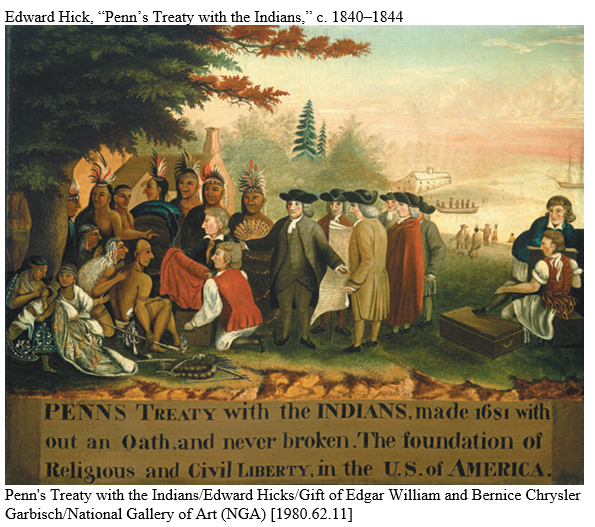
The image of William Penn with the Indians most directly reflects which of the following?
A. the proprietor of Pennsylvania’s goal to convert Native Americans to Christianity
B. the proprietor of Pennsylvania’s goal to relocate the Indians in his colonial territory to a designated sanctuary
C. the proprietor of Pennsylvania’s goal to establish a peaceful relationship with the Indians in his colonial territory
D. the proprietor of Pennsylvania’s goal to sell European products to the Indians in his colonial territory
C. the proprietor of Pennsylvania’s goal to establish a peaceful relationship with the Indians in his colonial territory
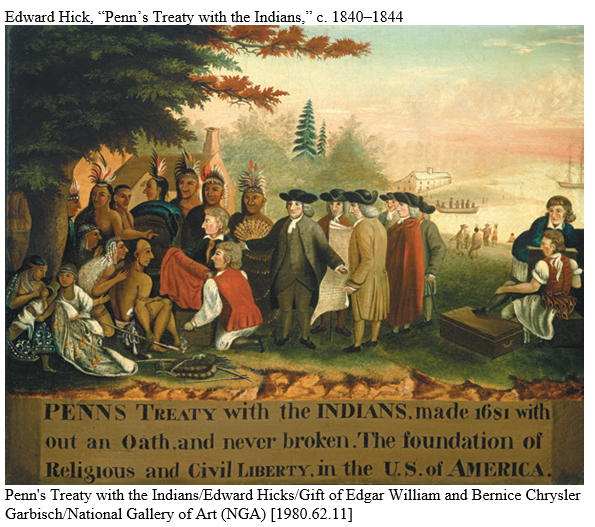
William Penn’s commitment to reimburse the Indians for their land best reflects the influence of which of the following?
A. Southern planters’ racial hierarchy ideas
B. Quaker principles of equality and pacifism
C. colonial merchants’ trade interests
D. Puritan motives to convert heathens
B. Quaker principles of equality and pacifism
In the 1620s, what increased conflict with Native Americans in the Jamestown colony?
A. the shift to tobacco production
B. the death of Pocahontas
C. the influx of African slaves
D. overpopulation
A. the shift to tobacco production
The Spanish reaction to French encroachments in Texas was the foundation of __________.
A. Taos
B. El Paso
C. Santa Fe
D. San Antonio
D. San Antonio
The cause of the Pueblo Revolt was harsh workloads and __________.
A. a severe drought
B. torturing of Pueblo leaders
C. religious repression
D. the cruelty of governor Don Diego de Vargas
C. religious repression

The image of Pocahontas most directly reflects which of the following?
A. the influence of English culture on Pocahontas’s costume, hairstyle, name, and religion
B. Pocahontas’s aversion to foreigners in her country
C. the English colonists’ adaptation to Native American customs
D. Native Americans’ desire to immigrate to England
A. the influence of English culture on Pocahontas’s costume, hairstyle, name, and religion
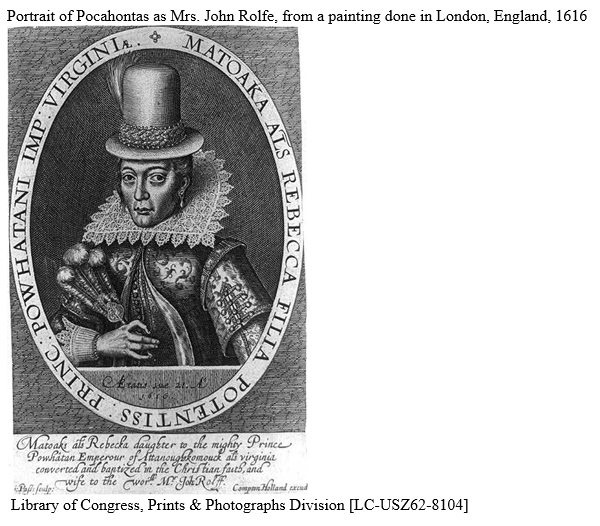
According to Captain John Smith’s account, one significant result of his rescue by Pocahontas was
A. an alliance with Chief Powhatan and the initial preservation of Jamestown.
B. the passage of a Jamestown law authorizing trade with Indians.
C. the release of Native American prisoners held by Jamestown settlers.
D. the relocation of the Jamestown settlement from the coast to further inland.
A. an alliance with Chief Powhatan and the initial preservation of Jamestown.
How did Bacon's Rebellion have a long-term impact on Virginia's social class system?
A. The lower classes successfully overthrew an aristocratic colonial government and ruled Virginia for nearly 150 years.
B. Native Americans living in Virginia gained greater political and social rights after the end of this rebellion.
C. Wealthy Virginia landowners drafted the first laws that kept blacks in permanent slavery.
D. Poor whites and enslaved Africans remained on the lower rungs of the Virginia class system after failing to overthrow the aristocratic colonial government.
D. Poor whites and enslaved Africans remained on the lower rungs of the Virginia class system after failing to overthrow the aristocratic colonial government.
What made relations between settlers in Plymouth (Pilgrims) and neighboring Native American tribes different from those in other English colonies?
A. The Pilgrims annihilated neighboring Native American tribes and confiscated their lands shortly after they established Plymouth.
B. Native Americans lived side by side in harmony with the Pilgrims for fifty years.
C. The Pilgrims and neighboring tribes created a successful military alliance that drove the Dutch out of New Amsterdam.
D. The Pilgrims intermarried with neighboring tribes and developed a mixed-race society in Plymouth.
B. Native Americans lived side by side in harmony with the Pilgrims for fifty years.
Why was King James I eager to see the Pilgrims leave England?
A. As Separatists, the Pilgrims believed they needed to form their own religious communities because they felt the Anglican Church was corrupt.
B. The Pilgrims gave women equal standing with men and allowed them to be ministers.
C. The Pilgrims wanted to restore Roman Catholicism as the official state religion in England.
D. The Pilgrims wanted to remain within the Anglican Church but believed that it had to be reformed to get rid of its connections to Catholic practices.
A. As Separatists, the Pilgrims believed they needed to form their own religious communities because they felt the Anglican Church was corrupt.
Which of the following are part of the New England colonies?
A. Massachusetts, New Hampshire, Rhode Island, and Connecticut
B. Rhode Island, Delaware, New Hampshire and New Jersey
C. New Hampshire, Connecticut, New York and New Jersey
D. Virginia, Massachusetts, and New Hampshire
A. Massachusetts, New Hampshire, Rhode Island, and Connecticut
“Why should you destroy us, who have provided you with food? What can you get by war? We can hide our provisions, and fly into the woods; and then you must consequently famish by wronging your friends…You see us unarmed, and willing to supply your wants, if you will come in a friendly manner, and not with swords and guns, as to invade an enemy. I am not so simple, as not to know it is better to eat good meat, lie well, and sleep quietly with my women and children; to laugh and be merry with the English; and, being their friend, to have copper, hatchets, and whatever else I want, … I … exhort you to peaceable councils; and, … I insist that the guns and swords, the cause of all our jealousy and uneasiness, be removed and sent away.”
--Chief Powhatan, “Remarks to John Smith”, John Smith, The Generall Historie of Virginia, New England & the Summer Isles, c. 1608
From Chief Powhatan’s perspective, which of the following contributed most directly to conflict between the Native Americans and the English settlers in early seventeenth-century Virginia?
A. Native Americans’ refusal to trade food for manufactured items with the English settlers
B. Native Americans’ desire to expel foreigners from their territory
C. English settlers’ aggressive use of force and weaponry to gain food from the Indians
D. English settlers’ desire to acquire the Native Americans as slaves
C. English settlers’ aggressive use of force and weaponry to gain food from the Indians
“Why should you destroy us, who have provided you with food? What can you get by war? We can hide our provisions, and fly into the woods; and then you must consequently famish by wronging your friends…You see us unarmed, and willing to supply your wants, if you will come in a friendly manner, and not with swords and guns, as to invade an enemy. I am not so simple, as not to know it is better to eat good meat, lie well, and sleep quietly with my women and children; to laugh and be merry with the English; and, being their friend, to have copper, hatchets, and whatever else I want, … I … exhort you to peaceable councils; and, … I insist that the guns and swords, the cause of all our jealousy and uneasiness, be removed and sent away.”
--Chief Powhatan, “Remarks to John Smith”, John Smith, The Generall Historie of Virginia, New England & the Summer Isles, c. 1608
The excerpt most directly reflects which of the following goals of Chief Powhatan?
A. to inspire his tribal followers to attack the Jamestown settlers
B. to provide the rationale for forming a confederation with neighboring Indian tribes
C. to end all contact with the English settlers
D. to reestablish peaceful trade with the English colonists
D. to reestablish peaceful trade with the English colonists
“Why should you destroy us, who have provided you with food? What can you get by war? We can hide our provisions, and fly into the woods; and then you must consequently famish by wronging your friends…You see us unarmed, and willing to supply your wants, if you will come in a friendly manner, and not with swords and guns, as to invade an enemy. I am not so simple, as not to know it is better to eat good meat, lie well, and sleep quietly with my women and children; to laugh and be merry with the English; and, being their friend, to have copper, hatchets, and whatever else I want, … I … exhort you to peaceable councils; and, … I insist that the guns and swords, the cause of all our jealousy and uneasiness, be removed and sent away.”
--Chief Powhatan, “Remarks to John Smith”, John Smith, The Generall Historie of Virginia, New England & the Summer Isles, c. 1608
One significant result of the contact between the English settlers and the Powhatan Indians was
A. the spread of disease and the decimation of Indian populations.
B. the establishment of a Virginia college for educating Indians.
C. the emergence of Powhatan missionaries who preached Christianity to their fellow Native Americans.
D. the discovery by Native Americans of silver mines on nearby islands.
A. the spread of disease and the decimation of Indian populations.
__________ was the leader of the Native Americans during King Philip's War.
A. Pope
B. Sassamon
C. Metacom
D. Powhatan
C. Metacom
_________________ was the first proprietary colony.
A. Georgia
B. Maryland
C. New York
D. Massachusetts
B. Maryland
Who was the founder of Rhode Island and worked closely with Wampanoag and Narragansett tribes?
A. Roger Williams
B. George Calvert
C. John Winthrop
D. John Smith
A. Roger Williams
What did Nathanial Bacon and Sir William Berkley have disputes over?
A. Growing tobacco or corn in Virginia
B. The use of African slaves on the plantations
C. The treatment of the Native Americans
D. If indentured servants should be allowed in Virginia
C. The treatment of the Native Americans
“For having upon specious pretences of public works, raised unjust taxes upon the commonality for the advancement of private favourites and other sinister ends, but no visible effects in any
measure adequate. …
For having wronged his Majesty’s prerogative and interest by assuming the monopoly of the beaver trade. …
For having protected, favoured and emboldened the Indians against his Majesty’s most loyal subjects, never contriving, requiring, or appointing any due or proper means of satisfaction for their many invasions, murders, and robberies committed upon us.
For having the second time attempted the same thereby calling down our forces from the defence of the frontiers, and most weak exposed places, for the prevention of civil mischief and ruin amongst ourselves, whilst the barbarous enemy in all places did invade, murder, and spoil us, his Majesty’s most faithful subjects.”
--Nathaniel Bacon, “The Declaration of the People,” 1676
According to the excerpt, which of the following was an important reason for the rebellion of Bacon and his followers against Governor Berkeley?
A. a theological dispute between the Anglicans and the Puritans
B. the influence of a major slave rebellion in South Carolina
C. the governor’s policy toward Indians which interfered with poor whites’ desire for land on the Virginia western frontier
D. the British policy of “salutary neglect” which avoided the strict enforcement of parliamentary laws
C. the governor’s policy toward Indians which interfered with poor whites’ desire for land on the Virginia western frontier
“For having upon specious pretences of public works, raised unjust taxes upon the commonality for the advancement of private favourites and other sinister ends, but no visible effects in any
measure adequate. …
For having wronged his Majesty’s prerogative and interest by assuming the monopoly of the beaver trade. …
For having protected, favoured and emboldened the Indians against his Majesty’s most loyal subjects, never contriving, requiring, or appointing any due or proper means of satisfaction for their many invasions, murders, and robberies committed upon us.
For having the second time attempted the same thereby calling down our forces from the defence of the frontiers, and most weak exposed places, for the prevention of civil mischief and ruin amongst ourselves, whilst the barbarous enemy in all places did invade, murder, and spoil us, his Majesty’s most faithful subjects.”
--Nathaniel Bacon, “The Declaration of the People,” 1676
Which of the following groups would be most likely to support the perspective of Nathaniel Bacon in the excerpt?
A. Tobacco merchants
B. Susquehanaug Indians
C. British royal officials
D. Landless freemen
D. Landless freemen
“For having upon specious pretences of public works, raised unjust taxes upon the commonality for the advancement of private favourites and other sinister ends, but no visible effects in any
measure adequate. …
For having wronged his Majesty’s prerogative and interest by assuming the monopoly of the beaver trade. …
For having protected, favoured and emboldened the Indians against his Majesty’s most loyal subjects, never contriving, requiring, or appointing any due or proper means of satisfaction for their many invasions, murders, and robberies committed upon us.
For having the second time attempted the same thereby calling down our forces from the defence of the frontiers, and most weak exposed places, for the prevention of civil mischief and ruin amongst ourselves, whilst the barbarous enemy in all places did invade, murder, and spoil us, his Majesty’s most faithful subjects.”
--Nathaniel Bacon, “The Declaration of the People,” 1676
One direct long-term effect of Bacon’s Rebellion was that it
A. led wealthy Virginians to prefer slave labor as they recognized the threat posed by former indentured servants.
B. increased colonists’ desire for an expanded British military presence in British North America.
C. stimulated the colonial independence movement that led to the American Revolution.
D. encouraged colonists to negotiate trade agreements with Native Americans.
A. led wealthy Virginians to prefer slave labor as they recognized the threat posed by former indentured servants.
Which two territories was William Penn granted?
A. Virginia and Pennsylvania
B. Virginia and Delaware
C. Maryland and Pennsylvania
D. Pennsylvania and Delaware
D. Pennsylvania and Delaware
__________ is a closed economic system that allowed for trade only between the colonies and the mother country.
A. Capitalism
B. The headright system
C. Mercantilism
D. Triangle Trade
C. Mercantilism
How were slave codes changed in the mid- to late 1600s in the colonies?
A. For the first time, corporal punishment of slaves was permitted, up to and including capital punishment.
B. It became easier for Indians to be enslaved.
C. Slavery became more permanent and an inherited status.
D. Free blacks lost their unique status and were re-enslaved.
C. Slavery became more permanent and an inherited status.
“That notwithstanding the ancient law of the country, made in the year 1633, that no person should sell any arms or ammunition to any Indian upon penalty of 10 [pounds] for every gun, 5 [pounds] for a pound of powder, and 40s for a pound of shot, yet the government of the Massachusetts in the year 1657, upon design to monopolize the whole Indian trade did publish and declare that the trade of furs…with the Indians in their jurisdiction did solely…belong to their commonwealth…giving liberty to all such as should have license from them to sell, unto any Indian, guns, swords, powder and shot…by which means the Indians have been abundantly furnished with great store of arms and ammunition to the utter ruin…of many families in the…colonies to enrich some few of their relations and church members.”
--Edward Randolph, “The Causes and Results of King Philip’s War,” 1675
Which of the following groups would be most likely to support the perspective of Edward Randolph in the excerpt?
A. colonial Massachusetts merchants
B. Massachusetts Indian tribes
C. English royal officials
D. members of the Massachusetts government
C. English royal officials
“Sometime since there was a Proclamation published at Augustine, in which the King of Spain (then at Peace with Great Britain) promised Protection and Freedom to all Negroes Slaves that would resort thither…Some Angola Negroes assembled, to the number of Twenty…they there killed Mr. Robert Bathurst, and Mr. Gibbs, plundered the House and took a pretty many small Arms and Powder…marched Southward along Pons Pons, which is the Road through Georgia to Augustine…they passed Mr. Wallace’s Tavern towards day break, and said they would not hurt him, for he was a good Man and kind to his Slaves…Several Negroes joined them, they calling out Liberty,…pursuing all the white people they met with, and killing Man Woman and Child when they could come up to them…”
--James Oglethorpe, The Stono Rebellion, 1739
Which of the following was an important precipitating factor for the Stono Rebellion?
A. competition between South Carolina planters and Georgia farmers to acquire slaves
B. the decreased supply of slaves from Africa in the early 1700s
C. an impending Spanish military attack on South Carolina
D. Spain’s promise of freedom for British colonists’ slaves who escaped to Florida
D. Spain’s promise of freedom for British colonists’ slaves who escaped to Florida
At the time of the American Revolution, what was the largest city in the colonies?
A. Boston
B. Philadelphia
C. New York
D. Balitmore
B. Philadelphia
The economic system of mercantilism was enforced by __________.
A. The Act of Union
B. The Navigation Acts
C. colonial legislatures
D. colonial militias
B. The Navigation Acts
Which geographic features contributed to the economic development of the plantation system in the South?
A. short rivers and many waterfalls
B. rich soil and warm climate
C. high mountains and numerous rivers
D. rocky soil and deep harbors
B. rich soil and warm climate
Which geographic feature was most important for the development of commerce in the New England and middle colonies?
A. long growing season
B. mountainous terrain
C. limited rainfall
D. natural harbors
D. natural harbors
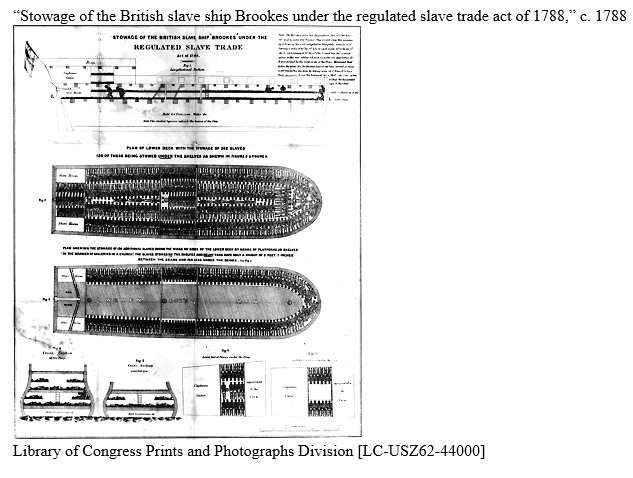
The diagram of the tightly-packed sections of a slave ship best serves as evidence of which of the following?
A. the traders’ desire to maximize profit, which overrode concerns for slaves’ health
B. the systematic representation and dimensional specification of eighteenth-century charts
C. the comfortable sleeping accommodations enjoyed by immigrants to America
D. the maximum efficiency achieved in eighteenth-century ship design
A. the traders’ desire to maximize profit, which overrode concerns for slaves’ health
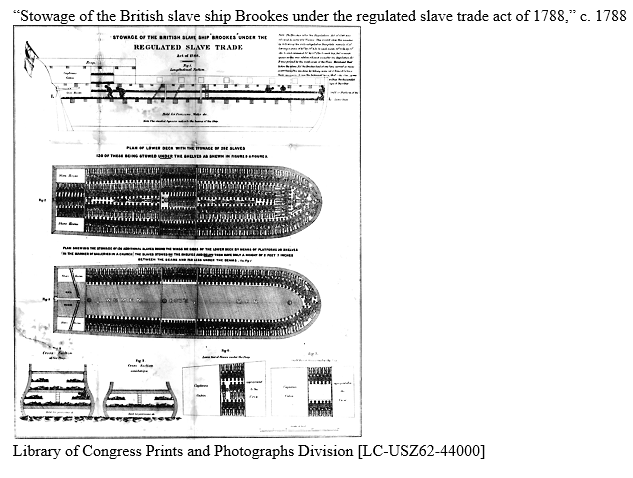
Which of the following was the most direct effect of the harsh conditions of the Middle Passage?
A. advances in medicine evoked by the exposure to African illnesses
B. a decrease in piracy raids on the Atlantic shipping
C. a rise in the number of slaves imported from the Middle East
D. the slaves’ high death rate due to the spread of disease
D. the slaves’ high death rate due to the spread of disease

Which of the following contributed most directly to the increase in the number of slaves transported to the New World after 1700?
A. the widespread promotional advertisements initiated by slave traders in the Caribbean islands
B. the effectiveness of the shipping efforts made by the American Colonization Society
C. the rise in the number of droughts, famines, and tribal conflicts that impoverished areas of Africa
D. increased European reliance on slave labor in response to the high cost of indentured servants and the dwindling supply of Native American laborers
D. increased European reliance on slave labor in response to the high cost of indentured servants and the dwindling supply of Native American laborers
“Sometime since there was a Proclamation published at Augustine, in which the King of Spain (then at Peace with Great Britain) promised Protection and Freedom to all Negroes Slaves that would resort thither…Some Angola Negroes assembled, to the number of Twenty…they there killed Mr. Robert Bathurst, and Mr. Gibbs, plundered the House and took a pretty many small Arms and Powder…marched Southward along Pons Pons, which is the Road through Georgia to Augustine…they passed Mr. Wallace’s Tavern towards day break, and said they would not hurt him, for he was a good Man and kind to his Slaves…Several Negroes joined them, they calling out Liberty,…pursuing all the white people they met with, and killing Man Woman and Child when they could come up to them…”
--James Oglethorpe, The Stono Rebellion, 1739
The events of the Stono Rebellion described in the excerpt have the most in common with which of the following?
A. Bacon’s Rebellion, 1676
B. Pueblo Revolt, 1680
C. New York Slave Revolt, 1712
D. The Glorious Revolution, 1689
C. New York Slave Revolt, 1712
What was the significance of the John Punch case?
A. The case ruled that the children born in the colonies took the place or status of their mothers
B. The case ruled that indentured servants have the right to land after they have completed working off their debt.
C. The case marked the beginning of the legal codification of race-based slavery in Virginia
D. The case allowed for Africans to represent themselves in a court of law.
C. The case marked the beginning of the legal codification of race-based slavery in Virginia
In Virginia, Partus Sequitur Ventrem ruled that
A. children who had at least one white parent could be an indetured servant and earn their freedom.
B. children of slaves could not be sold to other plantations.
C. children of slaves were not allowed to receive lashes as a punishemnt until they turned 14 years of age
D. children born in the colonies took the place or status of their mothers
D. children born in the colonies took the place or status of their mothers

Which of the following contributed most directly to the large number of slaves in the southern colonies?
A. the Puritan religious opposition to slavery in New England
B. the development of labor-intensive, profitable crops such as tobacco, rice, and indigo in the southern colonies
C. the southern colonies’ proximity to the West Indies
D. the imposition of heavy taxes on slave owners in the northern colonies
B. the development of labor-intensive, profitable crops such as tobacco, rice, and indigo in the southern colonies
Which of the following statements accurately describes the early history of New York?
A. New York was initially established as a British colony named New York in 1626, but it was later conquered by the Dutch in 1660 and renamed New Amsterdam.
B. In 1664, King Charles II of England granted the colony of New Amsterdam to his brother, the Duke of York, who then conquered it from the Dutch, renaming it New York.
C. The area now known as New York was originally a French colony called New France and was later renamed New York by the Dutch in the 1600s.
D. The area now known as New York was originally a Spanish settlement that was conquered by the British and renamed New York in the late 1600s.
B. In 1664, King Charles II of England granted the colony of New Amsterdam to his brother, the Duke of York, who then conquered it from the Dutch, renaming it New York.
The French and Indian War was triggered by
A. the desire of both sides to pull their economies out of depression
B. the expansionist policies of Louis XIV, leading to millions of French colonists
C. conflicting French and English claims to the Ohio Valley
D. French anger over English restrictions on trade and shipping.
C. conflicting French and English claims to the Ohio Valley
Following the French and Indian War, what was significantly different about the way whites in British North America began viewing the American Indians?
A. The fear and distrust their ancestors had of the American Indians gradually gave way to a sense of shared community after whites and their Indian neighbors fought side by side in the war.
B. Having eliminated its European rivals from North America in the war, British colonial governors convened the first of many peace talks intended to end years of conflict between Indian tribes.
C. Following the war, the British government wished to avoid further conflict in North America and instructed colonial governments to pursue practical means of integrating the Indian population into colonial society
D. Many white residents of British North America began to lump all American Indians together as an enemy race, while previous generations had viewed the different tribes separately from each other.
D. Many white residents of British North America began to lump all American Indians together as an enemy race, while previous generations had viewed the different tribes separately from each other.
What cause-and-effect correlation can be found between the concluding circumstances of the French and Indian War and the American War for Independence that erupted some twenty years later?
A. Being heavily in debt following the French and Indian War, Britain expected that the North American colonists who had benefited from the war should help pay off Britain's debt through elevated taxation.
B. During the French and Indian War, the British army's impressment of young American Indian males further fueled anti-British sentiment in North America.
C. England's insistence that France continue sharing responsibility for maintaining peace between colonists and Indian tribes would inevitably force the colonists to align themselves with whichever of the two European powers was most likely to support their desire for further westward expansion.
D. The treaty ending the French and Indian War had left many issues unresolved, including border disputes between English and French settlers west of the Appalachians, ensuring conflict would return.
A. Being heavily in debt following the French and Indian War, Britain expected that the North American colonists who had benefited from the war should help pay off Britain's debt through elevated taxation.
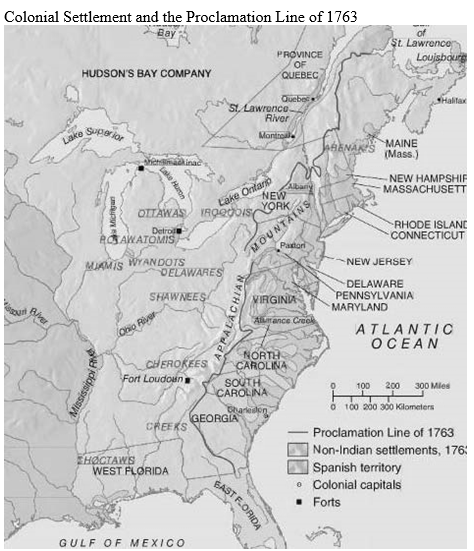
According to the map, which of the following was west of the Proclamation Line of 1763?
A. land reserved for the colonial American veterans of the French and Indian War
B. the colonists’ settlements of Ohio and Mississippi
C. the French territories of Loudoun and Detroit
D. land reserved for the tribes that had supported the French and Indian War
D. land reserved for the tribes that had supported the French and Indian War
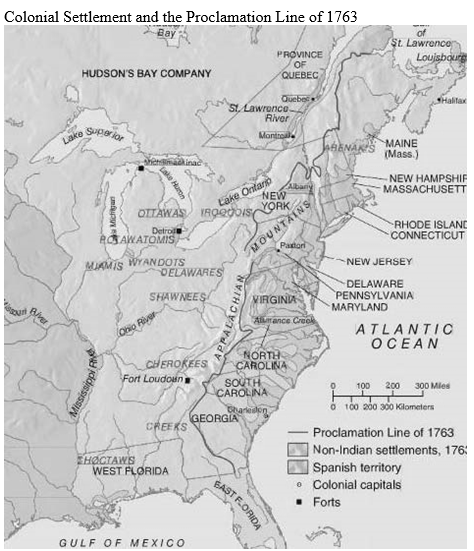
Which of the following events most directly contributed to the establishment of the Proclamation Line of 1763?
A. Bacon’s Rebellion
B. Shay’s Rebellion
C. Pontiac’s Rebellion
D. Boston Massacre
C. Pontiac’s Rebellion
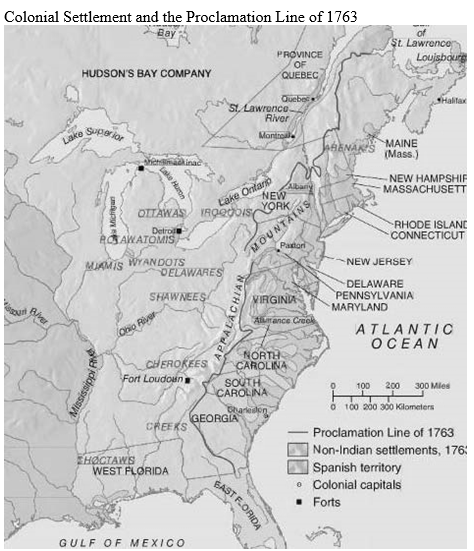
One direct long-term effect of the Proclamation Line’s prohibition of colonial settlement west of the Appalachians was the
A. end of the Spanish empire in the Americas because of the British annexation of Canada.
B. establishment of peaceful relations between the colonists and the Indians.
C. Spanish alliance with the former French inhabitants of Florida.
D. American Revolution because land-hungry colonists resented the king’s ban.
D. American Revolution because land-hungry colonists resented the king’s ban.
Which of the following revolutionary groups originated with middle- and upper-class New Yorkers as a secret underground resistance movement to the Stamp Act?
A. the Paxton Boys
B. the Sons of Liberty
C. Loyalists
D. the Augusta Boys
B. the Sons of Liberty
What is notable about the series of acts passed by the British Parliament in the years leading up to America's war for independence that may have, in fact, contributed to America's success in that war?
A. Parliament's Acts targeted all segments of the North American population and thus unintentionally provoked a common sense of grievance among people who had previously been quite separate in their complaints.
B. Though passed separately over a fifteen-year period before the war, the laws principally impacted the merchant class, which had the greatest likelihood of funding a revolutionary campaign that served their interests.
C. The impact of this series of laws passed over a decade-long period was felt not only by colonists but also by the British troops occupying the colonies, who would gradually become sympathetic to the colonial cause.
D. The Acts of Parliament in the years preceding the American Revolution were equally unpopular in England and made it possible for America to successfully use propaganda to turn English public opinion against a prolonged war in America.
A. Parliament's Acts targeted all segments of the North American population and thus unintentionally provoked a common sense of grievance among people who had previously been quite separate in their complaints.
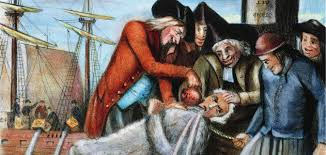
The eighteenth-century political cartoon most directly reflects which of the following?
A. the bias against women in colonial America society
B. colonists’ mistreatment of the Iroquois Indians
C. several forms of colonists’ resistance to British taxes
D. British officials’ punishments of colonial smugglers
C. several forms of colonists’ resistance to British taxes
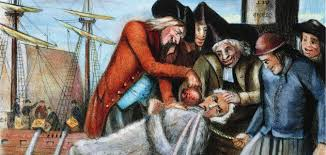
The image depicts the tarring and feathering, a ritual of public humiliation, of which one of the following?
A. a colonial American patriot
B. King George III
C. a Native American chief
D. a Loyalist tax collector
D. a Loyalist tax collector
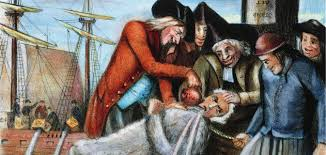
The background scene of Boston colonists dumping material off of a ship suggests that they were reacting to
A. the Stamp Act of 1765.
B. the Tea Act of 1773.
C. the Sugar Act of 1764.
D. the Intolerable Acts of 1774.
B. the Tea Act of 1773.
Which battle is known as The “shot heard round the world” as the Revolutionary War began when local minutemen were fired upon by British redcoats outside of Boston?
A. Bunker Hill
B. Saratoga
C. Lexington & Concord
D. Trenton
C. Lexington & Concord
The __________ was an assembly of delegates who met in Philadelphia, declared the independence of a newly named United States of America, adopted a new plan for self-government, and orchestrated the war for the country's independence from Britain.
A. Council of British Governors
B. First Continental Congress
C. Second Continental Congress
D. Boston Tea Party
C. Second Continental Congress
In what way did Thomas Paine's publication of Common Sense shape public opinion at a critical juncture during the Revolutionary War period?
A. Paine's abolitionist treatise provided justification for arming slaves and allowing them to join the Continental Army.
B. Divisions within the Second Continental Congress over who should lead the Continental Army were resolved when Paine publicly endorsed George Washington.
C. Paine's publication promoted separation from British rule while many Americans, including the Second Continental Congress, were still debating whether independence was a goal they wanted from the war.
D. Following the Continental Army's defeat at Saratoga and considerations of surrender, Paine's publication reinvigorated the patriot cause.
C. Paine's publication promoted separation from British rule while many Americans, including the Second Continental Congress, were still debating whether independence was a goal they wanted from the war.
“Young ladies in town, and those that live round,
Let a friend at this season advise you:
Since money’s so scarce, and times growing worse,
Strange things may soon hap and surprise you;
First then, throw aside your high top knots of pride,
Wear none but your own country linen,
Of Economy boast, let your pride be the most
To show clothes of your own make and spinning.”
--“Address to the Ladies,” Boston Post-Boy & Advertiser, 1767
According to the excerpt, groups of patriotic women who called themselves “Daughters of Liberty” met to do which of the following?
A. spin their own yarn and make their own cloth
B. sip tea and gossip about their neighbors
C. bake goods to sell for their household needs
D. shop for new linen and get their hair curled
A. spin their own yarn and make their own cloth
“Young ladies in town, and those that live round,
Let a friend at this season advise you:
Since money’s so scarce, and times growing worse,
Strange things may soon hap and surprise you;
First then, throw aside your high top knots of pride,
Wear none but your own country linen,
Of Economy boast, let your pride be the most
To show clothes of your own make and spinning.”
--“Address to the Ladies,” Boston Post-Boy & Advertiser, 1767
The excerpt most clearly demonstrates that colonial women participated in the struggle against unfair British measures as
A. consumers refusing to purchase imported British goods.
B. rioters protesting in the streets against royal officials.
C. laundresses accompanying the colonial troops fighting the British.
D. spies gathering information about the Loyalists in their areas.
A. consumers refusing to purchase imported British goods.
“Young ladies in town, and those that live round,
Let a friend at this season advise you:
Since money’s so scarce, and times growing worse,
Strange things may soon hap and surprise you;
First then, throw aside your high top knots of pride,
Wear none but your own country linen,
Of Economy boast, let your pride be the most
To show clothes of your own make and spinning.”
--“Address to the Ladies,” Boston Post-Boy & Advertiser, 1767
One significant result of the women’s efforts described in the excerpt was the
A. British merchants’ loss of profit and the repeal of the Stamp Act.
B. development of a colonial American woman’s rights movement and the extension of suffrage.
C. creation of an alliance with British women and a homespun clothing industry.
D. increase in British hat manufacturers’ profit and the extension of hat duties.
A. British merchants’ loss of profit and the repeal of the Stamp Act.
Which statement offers the best explanation of the events that precipitated the American Revolution's opening battles at Lexington and Concord?
A. General Thomas Gage, who had been serving as royal governor in Boston, fled the city's riots to nearby Lexington and Concord, and when British troops attempted a rescue, the colonial militia attacked.
B. While attempting to restore order in Boston, British General Thomas Gage learned the colonial militia was stockpiling weapons in nearby Concord and ordered his troops to secure these weapons
C. . The British Parliament ordered General Thomas Gage to arrest the rebellious city leaders of Lexington and Concord who were the principal distributors of anti-British propaganda
D. British General Thomas Gage was on his way to Boston to quell the riots there, as ordered by Parliament, when his army was confronted by colonial militia at Lexington and Concord, preventing him from going any farther.
B. While attempting to restore order in Boston, British General Thomas Gage learned the colonial militia was stockpiling weapons in nearby Concord and ordered his troops to secure these weapons
“… several soldiers … were seen parading the streets with their drawn cutlasses and bayonets, abusing and wounding numbers of the inhabitants … Thirty or forty persons, mostly lads, …gathered in King Street, Capt. Preston with a party of men with charged bayonets, came from the main guard to the commissioner’s house, the soldiers pushing their bayonets, crying, make way! They … pricked some in several places, on which they were clamorous and, it is said, threw snow balls. … the Captain commanded them to fire; … One soldier then fired, and a townsman with a cudgel struck him over the hands with such force that he dropped his firelock; and, rushing forward, aimed a blow at the Captain’s head which grazed his hat and fell pretty heavy upon his arm. However, the soldiers continued the fire successively till seven or eight or, as some say, eleven guns were discharged.”
--George Sanderlin’s Account of the Boston Massacre, Boston Gazette and Country Journal, 1770
The description of the Boston Massacre best serves as evidence of which of the following?
A. the British government’s view that the colonists were loyal British subjects
B. the colonists’ view that the British military had fired unfairly upon an unarmed crowd
C. the colonists’ view that the British military acted heroically in dealing with a group of ruffians
D. the British military’s view that the colonists had unfairly tormented them
B. the colonists’ view that the British military had fired unfairly upon an unarmed crowd
“… several soldiers … were seen parading the streets with their drawn cutlasses and bayonets, abusing and wounding numbers of the inhabitants … Thirty or forty persons, mostly lads, …gathered in King Street, Capt. Preston with a party of men with charged bayonets, came from the main guard to the commissioner’s house, the soldiers pushing their bayonets, crying, make way! They … pricked some in several places, on which they were clamorous and, it is said, threw snow balls. … the Captain commanded them to fire; … One soldier then fired, and a townsman with a cudgel struck him over the hands with such force that he dropped his firelock; and, rushing forward, aimed a blow at the Captain’s head which grazed his hat and fell pretty heavy upon his arm. However, the soldiers continued the fire successively till seven or eight or, as some say, eleven guns were discharged.”
--George Sanderlin’s Account of the Boston Massacre, Boston Gazette and Country Journal, 1770
Which of the following contributed most directly to the Boston Massacre?
A. the efforts of prominent Boston Loyalists to mobilize support for the king
B. the proposal to install a bishop of the Church of England in Boston
C. the stationing of British troops in Boston to assert Parliament’s authority
D. the Boston Tea Party’s destruction of East India Company tea
C. the stationing of British troops in Boston to assert Parliament’s authority
“… several soldiers … were seen parading the streets with their drawn cutlasses and bayonets, abusing and wounding numbers of the inhabitants … Thirty or forty persons, mostly lads, …gathered in King Street, Capt. Preston with a party of men with charged bayonets, came from the main guard to the commissioner’s house, the soldiers pushing their bayonets, crying, make way! They … pricked some in several places, on which they were clamorous and, it is said, threw snow balls. … the Captain commanded them to fire; … One soldier then fired, and a townsman with a cudgel struck him over the hands with such force that he dropped his firelock; and, rushing forward, aimed a blow at the Captain’s head which grazed his hat and fell pretty heavy upon his arm. However, the soldiers continued the fire successively till seven or eight or, as some say, eleven guns were discharged.”
--George Sanderlin’s Account of the Boston Massacre, Boston Gazette and Country Journal, 1770
One significant result of the event described in the excerpt was that the
A. Proclamation Line of 1763 was revoked by King George III as a gesture of reconciliation.
B. Stamp Act was repealed and the Declaratory Act was passed.
C. Boston Massacre became a symbol of British military heroism.
D. Boston Massacre became a crucial element of anti-British propaganda in the colonies.
D. Boston Massacre became a crucial element of anti-British propaganda in the colonies.
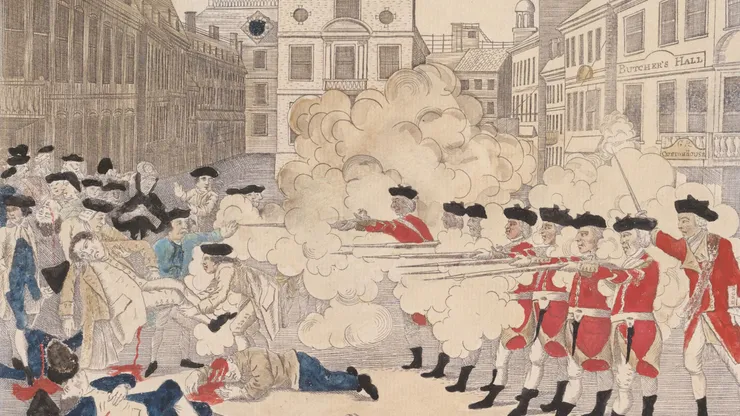
Which of the following statements accurately shown in the picture above?
A. It was a large-scale protest led by colonial leaders to demand the repeal of the Stamp Act.
B. It was a formal declaration by the British government to end all trade restrictions on the American colonies.
C. It was an incident in which British troops fired into a crowd of colonists, killing five, and was used as propaganda to galvanize anti-British sentiment.
D. It was a violent clash between British soldiers and colonial militia that resulted in the first major battle of the American Revolution.
C. It was an incident in which British troops fired into a crowd of colonists, killing five, and was used as propaganda to galvanize anti-British sentiment.
The purpose of the Intolerable Act (Coercive Acts) was to
A. abolish the colonial assemblies
B. punish Boston for the Tea Party
C. outlaw any public criticism of British policy
D. arrest the leaders of the Sons of Liberty
B. punish Boston for the Tea Party
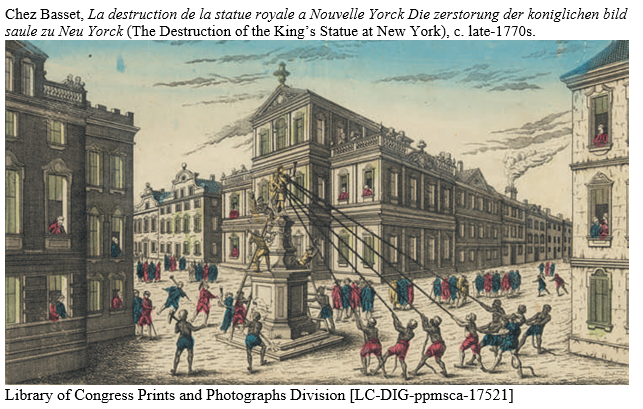
The image depicting the destruction of the statue of King George III most directly reflects which of the following?
A. preparation for the installation of the statue of President George Washington
B. the cooperation of blacks and whites in urban labor
C. the Declaration of Independence’s abolishment of monarchical rule
C. the Declaration of Independence’s abolishment of monarchical rule
Which of the following was a result of the Battle of Saratoga?
A. France’s entry on the American side
B. a new invasion of Canada
C. serious peace negotiations with the British
D. the greatest loss the Americans had ever suffered
A. France’s entry on the American side
Which of the following best describes the significance of the Battle of Saratoga in the American Revolutionary War?
A. It marked the end of British attempts to conquer New England and shifted the focus of the war to the southern colonies.
B. It was a turning point that secured French military support for the American colonies, significantly altering the course of the war.
C. It was a decisive American victory that resulted in the capture of General Cornwallis and effectively ended the war.
D. It was the first major battle of the American Revolution and led directly to the Declaration of Independence.
B. It was a turning point that secured French military support for the American colonies, significantly altering the course of the war.
Who was a Lt. Colonel in the Virginia militia at the onset of the French and Indian War in 1754 and, twenty years later, commanded the Continental Army in America's successful war for independence?
A. Henry Knox
B. George Washington
C. John Adams
D. Benedict Arnold
B. George Washington
What was the legal argument of American patriots for labeling a series of laws passed by the British Parliament in 1764–1774 as "Intolerable Acts"?
A. Dealing as they each did with matters of religion, these particular laws only served to further divide colonial society.
B. By enacting laws authored by England's monarch that had not been consented to by the British Parliament, the laws violated the British constitution.
C. By enacting these laws with no representation from the colonists, Britain was violating the rights of English subjects in North America.
D. Dealing as they did with matters relevant in England, these particular laws were not only pointless but also unenforceable.
C. By enacting these laws with no representation from the colonists, Britain was violating the rights of English subjects in North America
The First Continental Congress marks the moment when
A. Americans realize they were no longer British in culture
B. Americans began the struggle to overcome local difference to pursue national goals
C. Americans realized they had too little in common to become a single nation
D. All ties to George III were explicitly rejected
B. Americans began the struggle to overcome local difference to pursue national goals
Which of the following accurately describes the Hessians of the Revolutionary War?
A. Hessians were no longer deployed when the war moved south
B. Hessians were German mercenaries hired by the British
C. Hessians were colonists who refused to support either side of the war
D. Few Hessians deserted the British army to join the American cause
B. Hessians were German mercenaries hired by the British
"I long to hear that you have declared an independency—and by the way in the new Code of Laws which I suppose it will be necessary for you to make I desire you would Remember the Ladies, and be more generous and favorable to them than your ancestors. Do not put such unlimited power into the hands of the Husbands. Remember all Men would be tyrants if they could. If particular care and attention is not paid to the Ladies we are determined to foment a Rebellion, and will not hold ourselves bound by any Laws in which we have no voice, or Representation. That your Sex are Naturally Tyrannical is a Truth so thoroughly established as to admit of no dispute, but such of you as wish to be happy willingly give up the harsh title of Master for the more tender and endearing one of Friend."
--Adams, Abigail. Letter from Abigail Adams to John Adams, 31 March - 5 April 1776. 4 pages. Original manuscript from the Adams Family Papers, Massachusetts Historical Society
The excerpt most directly reflects which of the following developments?
A. The American Revolution weas motivated by colonists’ desire to revise the legal code
B. During the American Revolution, women’s religious fervor increased.
C. The American Revolution created an increased awareness of inequalities in society among some women
C. The American Revolution created an increased awareness of inequalities in society among some women
"I long to hear that you have declared an independency—and by the way in the new Code of Laws which I suppose it will be necessary for you to make I desire you would Remember the Ladies, and be more generous and favorable to them than your ancestors. Do not put such unlimited power into the hands of the Husbands. Remember all Men would be tyrants if they could. If particular care and attention is not paid to the Ladies we are determined to foment a Rebellion, and will not hold ourselves bound by any Laws in which we have no voice, or Representation. That your Sex are Naturally Tyrannical is a Truth so thoroughly established as to admit of no dispute, but such of you as wish to be happy willingly give up the harsh title of Master for the more tender and endearing one of Friend."
--Adams, Abigail. Letter from Abigail Adams to John Adams, 31 March - 5 April 1776. 4 pages. Original manuscript from the Adams Family Papers, Massachusetts Historical Society
Which of the following would most directly prompt Abigail Adams’ husband to disregard his wife’s plea for full citizenship rights?
A. His small amount of influence in the Continental Congress
B. His assumption that his wife was mentally deficient
C. His lack of time and attention while participating in the fight for American independence
D. His belief that women, like children, slaves, and non-propertied men, lacked the independence required of republican citizens
D. His belief that women, like children, slaves, and non-propertied men, lacked the independence required of republican citizens
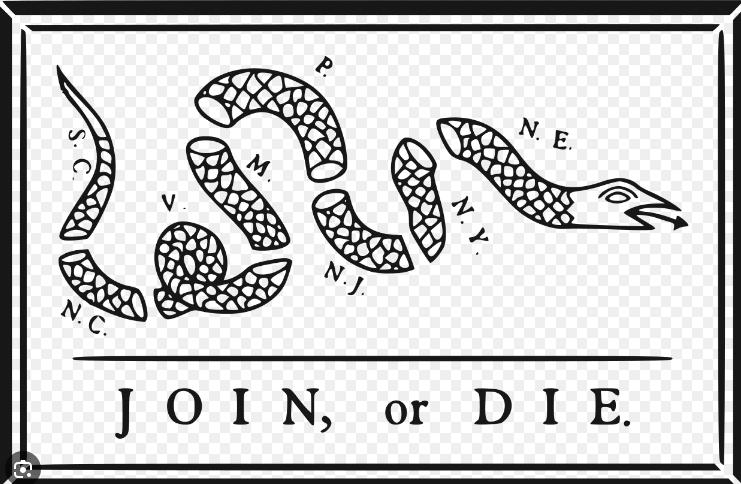
The political cartoon created by Benjamin Franklin in 1754 most directly reflects which of the following?
A. A warning to the American colonies to unite or be defeated by a common enemy
B. A warning to the colonists regarding the danger of rattlesnakes
C. A warning to the British royal officials to cooperate with colonial interests.
D. An encouragement to the colonists to join voluntary organizations
A. A warning to the American colonies to unite or be defeated by a common enemy
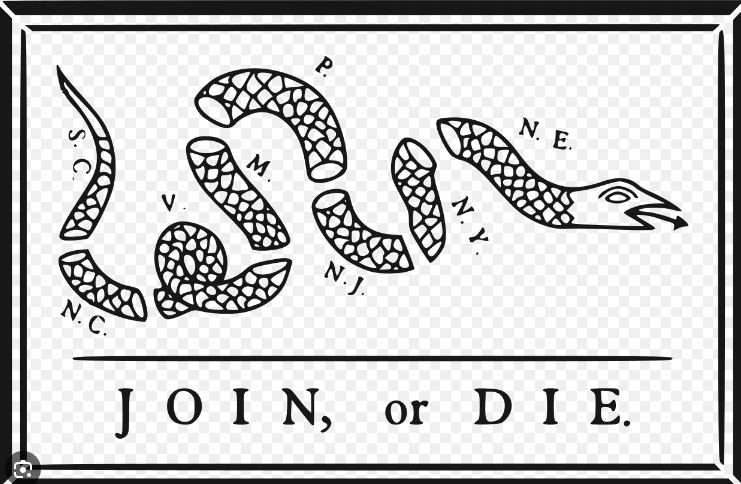
Which of the following factors most directly contributed to the sentiments of the cartoon?
A. The tyranny exercised by the British monarchy
B. The effects on the colonial economy of the shortage of paper money
C. The drought conditions that resulted in numerous rattlesnake sightings
D. The danger posed by the French and their Indian allies
D. The danger posed by the French and their Indian allies
Bunker Hill was
A. boosted the Continental Army’s morale and inspired troops to re-enlist for the next year. It also attracted new recruits from across the 13 Colonies.
B. the first major defeat for the Continental Army, who suffered heavy losses. They wanted to rally support in Canada for the American cause.
C. a British victory on the hills north of Boston. However, it was costly in terms of casualties, and it showed the Americans were a formidable force.
D. the “largest all-American fight” as Loyalist & Patriot militias fought at NC/SC border. Patriot victory that forced Cornwallis to abandon plans for an invasion on NC.
C. a British victory on the hills north of Boston. However, it was costly in terms of casualties, and it showed the Americans were a formidable force.
Which battle was an American victory that convinced France to join the war as an American ally and prevented the British from dividing New England from the rest of the colonies
A. Yorktown
B. Saratoga
C. Bunker Hill
D. Lexington & Concord
B. Saratoga
Who was a a Prussian military officer that helped George Washington with providing important training for the American troops was
A. Nathaniel Greene
B. Baron Friedrich von Steuben
C. Benedict Arnold
D. Thomas Gage
B. Baron Friedrich von Steuben
The ___________________ imposed duties on imported goods such as glass, paper, paint, and tea which resulted in _____________________.
A. Intolerable Acts, Boston Tea Party
B. Sugar Act, smuggling
C. Stamp Act, boycotts against the British
D. Townshend Acts, Boston Massacre
D. Townshend Acts, Boston Massacre
Which of the following statements accurately describes the Olive Branch Petition of 1775?
A. It was a formal declaration of independence from Britain that marked the beginning of the Revolutionary War.
B. It was a document sent by the Continental Congress to King George III, expressing the colonies' desire for peace and reconciliation while asserting their grievances.
C. It was a treaty negotiated with France to secure military support against Britain.
D. It was a proposal for a new government structure in the American colonies, including provisions for a central executive and legislature.
B. It was a document sent by the Continental Congress to King George III, expressing the colonies' desire for peace and reconciliation while asserting their grievances.
The Declaration of Independence, adopted on July 4, 1776, was primarily authored by which individual?
A. Thomas Jefferson
B. John Adams
C. James Madison
D. George Washington
A. Thomas Jefferson
Supporters of the Constitution, known as Federalists, believed that __________.
A. the Articles of Confederation had given too much power to Congress
B. only a strong central government could solve the country's problems
C. the country's problems were best solved by state governments
D. slavery was essential to the country's well-being
B. only a strong central government could solve the country's problems
Which of these provisions of the Northwest Ordinance of 1787 was largely unenforced?
A. the ban on slavery
B. the mandate for religious freedom
C. the requirement of fair treatment of the Indians
D. the mandate for public schools
C. the requirement of fair treatment of the Indians
Who was was the primary author of the Virginia Plan?
A. John Adams
B. Alexander Hamilton
C. Thomas Jefferson
D. James Madison
D. James Madison
“I long to hear that you have declared an independency—and by the way in the new Code of Laws which I suppose it will be necessary for you to make I desire you would Remember the Ladies, and be more generous and favorable to them than your ancestors. Do not put such unlimited power into the hands of the Husbands. Remember all Men would be tyrants if they could. If particular care and attention is not paid to the Ladies we are determined to foment a Rebellion, and will not hold ourselves bound by any Laws in which we have no voice, or Representation. That your Sex are Naturally Tyrannical is a Truth so thoroughly established as to admit of no dispute, but such of you as wish to be happy willingly give up the harsh title of Master for the more tender and endearing one of Friend.”
--Adams, Abigail. Letter from Abigail Adams to John Adams, 31 March - 5 April 1776. 4 pages. Original manuscript from the Adams Family Papers, Massachusetts Historical Society
The excerpt most directly reflects which of the following developments?
A. The American Revolution created an increased awareness of inequalities in society among some women.
B. During the American Revolution, women’s religious fervor increased.
C. During the American Revolution, women participated in the Continental Congress.
D. The American Revolution was motivated by colonists’ desire to revise the legal code.
A. The American Revolution created an increased awareness of inequalities in society among some women.
“I long to hear that you have declared an independency—and by the way in the new Code of Laws which I suppose it will be necessary for you to make I desire you would Remember the Ladies, and be more generous and favorable to them than your ancestors. Do not put such unlimited power into the hands of the Husbands. Remember all Men would be tyrants if they could. If particular care and attention is not paid to the Ladies we are determined to foment a Rebellion, and will not hold ourselves bound by any Laws in which we have no voice, or Representation. That your Sex are Naturally Tyrannical is a Truth so thoroughly established as to admit of no dispute, but such of you as wish to be happy willingly give up the harsh title of Master for the more tender and endearing one of Friend.”
--Adams, Abigail. Letter from Abigail Adams to John Adams, 31 March - 5 April 1776. 4 pages. Original manuscript from the Adams Family Papers, Massachusetts Historical Society
Which of the following would most directly prompt Abigail Adams’ husband to disregard his wife’s plea for full citizenship rights?
A. his assumption that his wife was mentally deficient
B. his lack of time and attention while participating in the fight for American independence
C.
“…the commotions in Massachusetts hurried me back to Boston…Our political machine, composed of thirteen independent sovereignties, have been perpetually operating against each other and against the federal head … Men at a distance, who have admired our systems of government…, are apt to accuse the rulers, and say that taxes have been assessed too high and collected too rigidly. This is a deception equal to any that has been hitherto entertained. That taxes may be the ostensible cause is true, but that they are the true cause is as far remote from truth as light from darkness. The people who are the insurgents have never paid any or but very little taxes. But they see the weakness of government: they feel at once their own poverty compared with the opulent, and their own force, and they are determined to make use of the latter in order to remedy the former….”
--Henry Knox, Letter to George Washington, 1786
Which of the following best reflects Henry Knox’s assessment of the Articles of Confederation government?
A. It was failing because of each state’s desire to retain its sovereignty.
B. It was failing because of the redistribution of wealth.
C. It was failing because of the tyranny of the federal executive.
D. It was failing because of Congress levying too many taxes.
A. It was failing because of each state’s desire to retain its sovereignty.
“…the commotions in Massachusetts hurried me back to Boston…Our political machine, composed of thirteen independent sovereignties, have been perpetually operating against each other and against the federal head … Men at a distance, who have admired our systems of government…, are apt to accuse the rulers, and say that taxes have been assessed too high and collected too rigidly. This is a deception equal to any that has been hitherto entertained. That taxes may be the ostensible cause is true, but that they are the true cause is as far remote from truth as light from darkness. The people who are the insurgents have never paid any or but very little taxes. But they see the weakness of government: they feel at once their own poverty compared with the opulent, and their own force, and they are determined to make use of the latter in order to remedy the former….”
--Henry Knox, Letter to George Washington, 1786
According to the excerpt, Shays’s Rebellion in Massachusetts was truly caused by which of the following?
A. the perceived weakness of the government and wealth inequality
B. the restlessness of ex-soldiers and the availability of weapons
C. the Massachusetts farmers’ poor crop harvests
D. the increase in taxes and the postwar economic depression
A. the perceived weakness of the government and wealth inequality
“…the commotions in Massachusetts hurried me back to Boston…Our political machine, composed of thirteen independent sovereignties, have been perpetually operating against each other and against the federal head … Men at a distance, who have admired our systems of government…, are apt to accuse the rulers, and say that taxes have been assessed too high and collected too rigidly. This is a deception equal to any that has been hitherto entertained. That taxes may be the ostensible cause is true, but that they are the true cause is as far remote from truth as light from darkness. The people who are the insurgents have never paid any or but very little taxes. But they see the weakness of government: they feel at once their own poverty compared with the opulent, and their own force, and they are determined to make use of the latter in order to remedy the former….”
--Henry Knox, Letter to George Washington, 1786
The sentiments expressed in the excerpt most directly contributed to which of the following?
A. the Hartford Convention
B. the Dominion of New England
C. the Newburgh Conspiracy
D. the Constitutional Convention
D. the Constitutional Convention
“Have they said, We, the states? Have they made a proposal of a compact between states? If they had, this would be a confederation. It is otherwise most clearly a consolidated government…Had these principles been adhered to, we should not have been brought to this alarming transition, from a confederacy to a consolidated government…Here is a resolution as radical as that which separated us from Great Britain. It is radical in this transition; our rights and privileges are endangered, and the sovereignty of the states will be relinquished: and cannot we plainly see that this is actually the case? The rights of conscience, trial by jury, liberty of the press, all your immunities and franchises, all pretensions to human rights and privileges are rendered insecure, if not lost, by this change, so loudly talked of by some, and inconsiderately by others.”
--Patrick Henry, “Speech against the Federal Constitution,” June 5, 1788
Which of the following groups would be most likely to support the perspective of Patrick Henry in the excerpt?
A. the Federalists
B. the Whigs
C. the Tories
D. the Antifederalists
D. the Antifederalists
“Have they said, We, the states? Have they made a proposal of a compact between states? If they had, this would be a confederation. It is otherwise most clearly a consolidated government…Had these principles been adhered to, we should not have been brought to this alarming transition, from a confederacy to a consolidated government…Here is a resolution as radical as that which separated us from Great Britain. It is radical in this transition; our rights and privileges are endangered, and the sovereignty of the states will be relinquished: and cannot we plainly see that this is actually the case? The rights of conscience, trial by jury, liberty of the press, all your immunities and franchises, all pretensions to human rights and privileges are rendered insecure, if not lost, by this change, so loudly talked of by some, and inconsiderately by others.”
--Patrick Henry, “Speech against the Federal Constitution,” June 5, 1788
In the excerpt, Henry’s fear of a “consolidated government” most directly reflects which of the following?
A. the belief that a strong national government will trample on the rights of individuals
B. the suspicion that an antislavery coalition will dominate the government
C. the perception that America will develop into a monarchy
D. the concern that state legislatures will be dissolved by the new government
A. the belief that a strong national government will trample on the rights of individuals
“Have they said, We, the states? Have they made a proposal of a compact between states? If they had, this would be a confederation. It is otherwise most clearly a consolidated government…Had these principles been adhered to, we should not have been brought to this alarming transition, from a confederacy to a consolidated government…Here is a resolution as radical as that which separated us from Great Britain. It is radical in this transition; our rights and privileges are endangered, and the sovereignty of the states will be relinquished: and cannot we plainly see that this is actually the case? The rights of conscience, trial by jury, liberty of the press, all your immunities and franchises, all pretensions to human rights and privileges are rendered insecure, if not lost, by this change, so loudly talked of by some, and inconsiderately by others.”
--Patrick Henry, “Speech against the Federal Constitution,” June 5, 1788
Which of the following was the most direct effect of the sentiments expressed in the excerpt?
A. the invention of the Electoral College
B. the addition of constitutional amendments known as the Bill of Rights
C. the development of the doctrine of judicial review
D. the eruption of the Nullification Crisis
B. the addition of constitutional amendments known as the Bill of Rights
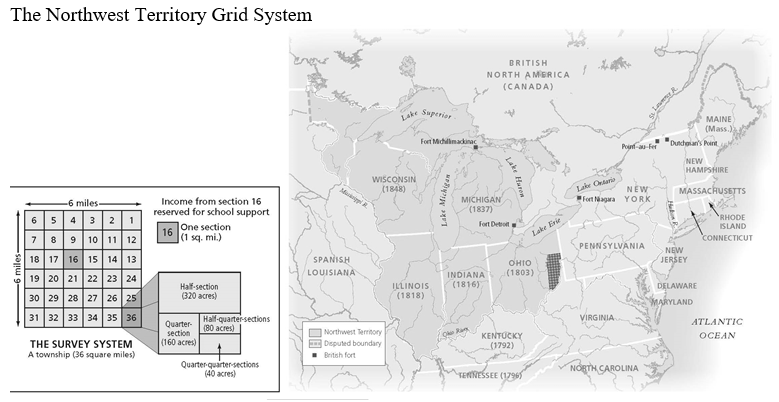
The image of the Northwest Territory most directly reflects which of the following developments in the eighteenth century?
A. the Northwest Ordinance’s orderly procedure for the creation of new states
B. Spain’s boundary disputes with the United States
C. the Northwest Ordinance’s establishment of religious freedom
D. the Northwest Territory’s conflicts with the Native Americans
A. the Northwest Ordinance’s orderly procedure for the creation of new states

The Northwest Ordinance of 1787 was one of the most significant accomplishments of which of the following?
A. the Second Continental Congress
B. the First Continental Congress
C. the Articles of Confederation Congress
D. the United States Congress
C. the Articles of Confederation Congress
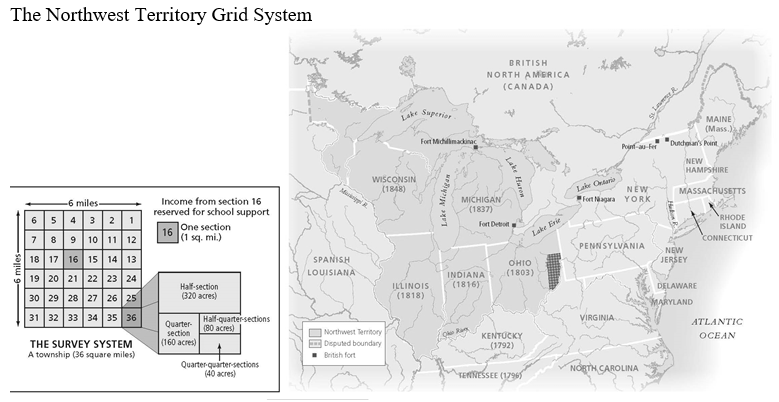
The Northwest Ordinance of 1787 provided the first
A. land grants for coeducational colleges.
B. construction of private Catholic schools in the U.S.
C. national reservation for Native Americans.
D. national limitation upon the expansion of slavery.
D. national limitation upon the expansion of slavery.
“… recall to your mind that time, in which the arms and tyranny of the British crown were exerted, … in order to reduce you to a state of servitude… you clearly saw into the injustice of a state of slavery, and … you publicly held forth this true and invaluable doctrine …: “We hold these truths to be self-evident, that all men are created equal; that they are endowed by their Creator with certain unalienable rights, and that among these are, life, liberty, and the pursuit of happiness.’’ … but, Sir, how pitiable is it to reflect, that although you were so fully convinced of the benevolence of the Father of Mankind, … that you should at the same time counteract his mercies, in detaining by fraud and violence so numerous a part of my brethren, under groaning captivity and cruel oppression….”
--Letter of Benjamin Banneker to Thomas Jefferson, 1791
The excerpt from a free black man’s letter to Jefferson most directly reflects which of the following?
A. the contradiction between the Declaration of Independence and Jefferson’s slave ownership
B. the division between British and American cultural attitudes
C. the contrast between the African American’s illiteracy and Jefferson’s advanced education
D. the difference between Banneker’s Christianity and Jefferson’s lack of religious devotion
A. the contradiction between the Declaration of Independence and Jefferson’s slave ownership
“… recall to your mind that time, in which the arms and tyranny of the British crown were exerted, … in order to reduce you to a state of servitude… you clearly saw into the injustice of a state of slavery, and … you publicly held forth this true and invaluable doctrine …: “We hold these truths to be self-evident, that all men are created equal; that they are endowed by their Creator with certain unalienable rights, and that among these are, life, liberty, and the pursuit of happiness.’’ … but, Sir, how pitiable is it to reflect, that although you were so fully convinced of the benevolence of the Father of Mankind, … that you should at the same time counteract his mercies, in detaining by fraud and violence so numerous a part of my brethren, under groaning captivity and cruel oppression….”
--Letter of Benjamin Banneker to Thomas Jefferson, 1791
The influence of the American Revolution’s emphasis on liberty can be seen in which of the following?
A. By the mid-nineteenth century, the apprenticeship system had ended.
B. By the 1830s, New England unions had condemned child labor.
C. By the 1830s, indentured servitude among immigrants had almost entirely ended in the U.S.
D. Prior to 1800, every northern state had begun the process of ending slavery.
D. Prior to 1800, every northern state had begun the process of ending slavery.
“… recall to your mind that time, in which the arms and tyranny of the British crown were exerted, … in order to reduce you to a state of servitude… you clearly saw into the injustice of a state of slavery, and … you publicly held forth this true and invaluable doctrine …: “We hold these truths to be self-evident, that all men are created equal; that they are endowed by their Creator with certain unalienable rights, and that among these are, life, liberty, and the pursuit of happiness.’’ … but, Sir, how pitiable is it to reflect, that although you were so fully convinced of the benevolence of the Father of Mankind, … that you should at the same time counteract his mercies, in detaining by fraud and violence so numerous a part of my brethren, under groaning captivity and cruel oppression….”
--Letter of Benjamin Banneker to Thomas Jefferson, 1791
The view of many Southern plantation owners that the Declaration of Independence did not invalidate their property rights in slaves led to
A. the First Amendment in the Bill of Rights.
B. their ban on slavery in the Northwest Territory.
C. the three-fifths clause compromise in the Constitution.
D. their support of a South Carolinian abolition society.
C. the three-fifths clause compromise in the Constitution.
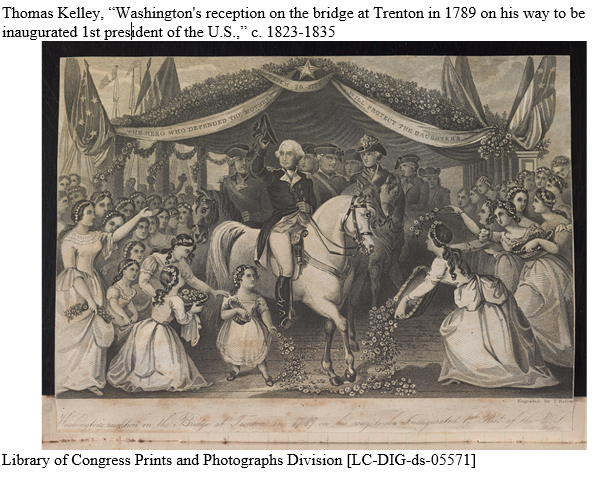
The image of Washington’s reception en route to his inauguration best serves as evidence of which of the following?
A. Washington viewed the presidency as a military, not a civilian, office.
B. Washington was only greeted by females on his way to the inauguration.
C. Washington re-enacted the Battle of Trenton in New Jersey
D. Washington’s election to the presidency was based on his military leadership in the American Revolution.
D. Washington’s election to the presidency was based on his military leadership in the American Revolution.
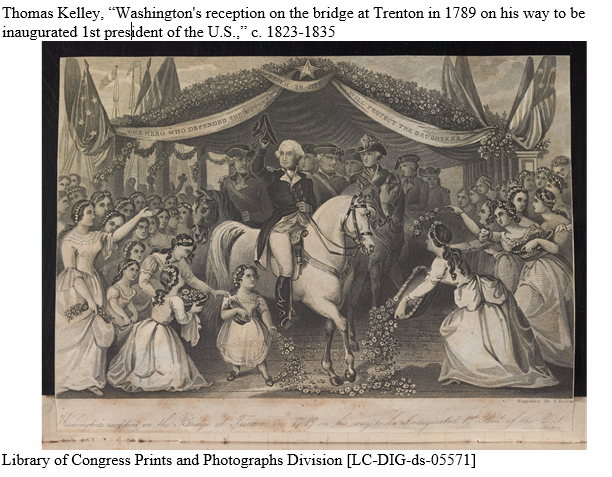
The image suggests that which of the following contributed most directly to consolidation of public support for the new American government?
A. the flourishing economy
B. Washington’s army
C. Washington’s personal prestige
D. women’s gratitudebn
C. Washington’s personal prestige
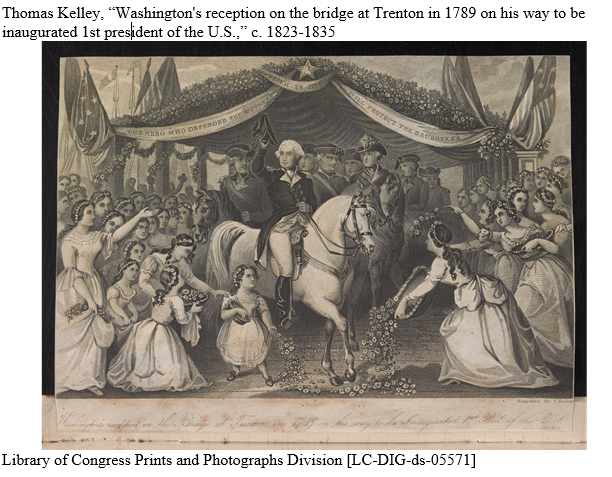
The unanimous election of Washington to the presidency most directly reflects which of the following?
A. No other American citizen was courageous enough to run for office.
B. Most of the founders of the nation opposed the idea of political parties
C. A corrupt bargain was made to ensure the South would retain slavery.
D. A majority of the American population voted in the election.
B. Most of the founders of the nation opposed the idea of political parties